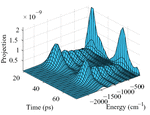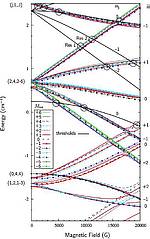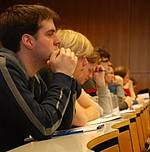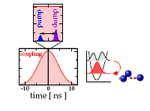Ultracold Collisions Near Feshbach Resonances
23 October 2009
Prof. Jeremy Hutson from the Universiy of Durham and collaborators form InSTES in Havana (Cuba) predict that low-energy inelastic cross-sections can both decrease and increase in the vicinity of a zero-energy Feshbach resonance. The external magnetic field can be used to tune the scattering lengths and reduce the inelastic collision rate almost to zero.
This work has been performed within the CoPoMol project and the article appeared in Phys. Rev. Lett 103, 163201 (2009).
Conical Intersections with Ultracold Molecules
2 September 2009
A recent article from QuDipMol shows that a suitable arrangement of fields may be used to to create a conical intersection as a function of external spatial coordinates. The effects of the resulting geometric phase on cold molecules are investigated in an article published in Physical Review Letters.
CoPoMol studies low-energy collisions
(7 August 2009)
A new study on the collisions of Rb atoms with NH3 and ND3 molecules assessing the viability of sympathetic colling for this systems has been published by CoPoMol in Physical Review A. Read more..

The role of spin-orbit coupling in the formation of RbCs ultracold molecules
(7 August 2009)
A new theoretical study from QuDipMol investigating the possibility of forming deeply bound ultracold RbCs molecules by two-color photoassociation is available in a recent issue of the open-access New Yournal of Physics . Read more...

Faraday Discussion and EuroQUAM satellite meeting on "Cold and Ultracold Molecules"
18 April 2009
Simon Cornish hosted a one day EuroQUAM satellite meeting on "Cold and Ultracold Molecules" following the 142nd Faraday Discussion held in Durham and chaired by Jeremy Hutson. The meeting was attended by around 60 scientists from throughout Europe involved in the ESF Cold Quantum Matter (EuroQUAM) EUROCORES Programme. A full day of stimulating talks saw each of the six collaborative research projects with the EuroQUAM programme represented, as well as two keynote talks given Jun Ye from JILA and Paul Julienne from NIST. Read more...
Young Atom Opticians meet in Vienna
21 February 2009
The EuroQUAM programme has sponsored this year's Young Atom Opticians (YAO) Conference that gathered young researchers from all the world interested in cold quantum matter phenomena. Read more...
Hyperfine energy levels of alkali-metal dimers in magnetic fields
(19 January 2009)
In the latest research paper published in Physical Review A, J.Aldegunde and J.Hutson form the collaborative research project QuDipMol reveal the hyperfine energy levels of alkali-metal dimers. Read more...
Bringing Atoms Closer Optically
(5 December 2008)
Researchers for CoPoMol report on ultracold molecules produced by an optical “two-color pump-dump” scheme in a recent issue of Physical Review A. Read more...
Formation of Ultracold Polar Molecules
(24 November 2008)
Professors Weidemüller’s group from the QuDipMol project has successfully produced ultracold LiCs molecules. The results appeared in a recent issue of Physical Review Letters with a viewpoint by Simon Cornish in the Physics journal of the American Physical Society. Read more...
QUDIPMOL Presents "Taken in a Trap" Experiments
(Paris, 14 November 2008)
Researchers from QUDIPMOL lead by Professor Matthias Weidemueller show real-time experiments to a large audience at the exhibition "Taken in a trap" at the Palais de la Decouverte in Paris. Read more about this dissemination event and the European City of Science.
(20 November 2008)
The group at the Department of Chemistry at Durham University lead by Professor Jeremy Hutson publishes the newest results on ultracold molecules in two Physical Review A articles. Read more...

Prospects for sympahtetic cooling of molecules (19 November 2008)
Scientists from CoPoMol have investigated ways of producing ultracold molecules by using sympathetic cooling in a recent issue of Physical Review A. More...







